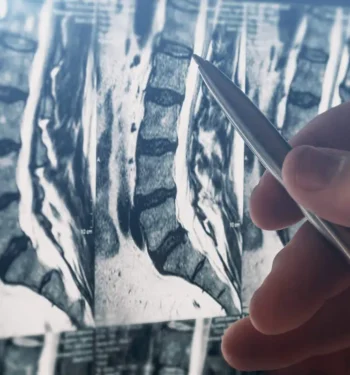
Understanding Spinal Fusion and Spinal Stenosis
Chronic back pain can be debilitating, and for many people, spinal stenosis is the root cause. Degenerative lumbar spinal stenosis occurs when the spaces within your spine narrow, putting pressure on the nerve roots. For those seeking spinal stenosis treatment in Indiana, understanding the options is key to finding pain relief. One effective surgical solution is spinal fusion surgery, often performed alongside spinal decompression to stabilize and alleviate symptoms.
This post explores when spinal fusion is deemed necessary, the different surgical approaches, and what to expect during recovery. If you’re considering treatment for spinal stenosis, ask your doctor about Goodman Campbell’s advanced technology and experience.
Is Spinal Fusion Recommended for Spinal Stenosis?
When nonsurgical treatments like physical therapy, medications, or injections are not effective in relieving symptoms, spinal fusion surgery may be recommended. Spinal fusion is most suitable for patients experiencing severe pain or mobility issues due to spinal stenosis.
Some individuals naturally develop fused vertebrae in their lower back as they age, which can provide stability. For those without this natural progression, surgical procedure intervention may be necessary. Ask your doctor about Goodman Campbell’s collaborative, subspecialized, patient-focused approach to help answer the question of “When is spinal fusion necessary?” and to determine exactly if spinal fusion is right for you.
What Are the Types of Spinal Fusion Surgery?
There are three main approaches to spinal fusion surgery:
- Posterior (from the back): Often used in lumbar decompression and fusion posterior procedures, this approach involves accessing the spine through an incision in the back.
- Anterior (from the front): Commonly performed in lumbar decompression and fusion lateral/anterior surgeries, this approach allows surgeons to remove damaged discs and stabilize the spine.
- Lateral (from the side): Lateral lumbar decompression and fusion combines stability with minimal disruption to surrounding tissues.
Minimally invasive fusion techniques are becoming the standard, using smaller incisions along with advanced tools to speed recovery. Many procedures — including spinal surgery with rods and screws, used to help secure and stabilize the spine during the healing process — are performed with greater precision and less disruption to surrounding tissues.
Goodman Campbell also uses artificial bone graft materials and has access to a bone bank to support effective bone healing during fusion procedures.
For more information, check out Goodman Campbell’s patient resources.
What Is the Success Rate of Spinal Fusion for Spinal Stenosis?
Spinal fusion surgery boasts a high success rate, with many patients experiencing significant improvements in pain and mobility. Studies show promising outcomes even 10 years after spinal fusion, with factors like adherence to rehabilitation plans influencing long-term results.* Life expectancy after spinal fusion can align with average standards when overall health is maintained.
Ask Goodman Campbell about our outstanding track record in spinal fusion surgery. Our dedication to expert care and positive patient outcomes is only matched by our commitment to innovation and long-term patient well-being.
What Are The Downsides of Spinal Fusion?
While spinal fusion can be highly effective, it’s essential to understand the potential challenges associated with it. The downside of spinal fusion may include reduced spinal mobility/flexibility and permanent restrictions after spinal fusion. Common problems after spinal fusion, such as persistent pain or nerve irritation, can also affect recovery. Discuss coping strategies and support services with your care team for the best outcomes, and be sure to consult Goodman Campbell’s resources, which provide excellent strategies to address these challenges.
What Can You Never Do Again After Spinal Fusion?
Post-spinal fusion surgery, there are certain restrictions to maintain your spine’s stability post-op. Activities involving heavy lifting, high-impact sports, or excessive twisting of the back are all generally discouraged as postoperative precautions. Recovery may also require adjusting your lifestyle to accommodate some permanent restrictions after spinal fusion. Patients can go on to engage in meaningful activities following spinal fusion, and your care team will work with you on restrictions. Engage with them to personalize your rehabilitation plan and ask your doctor about Goodman Campbell’s evidence-based recommendations as you prepare to safely return to physical activities.
Preparing for and Recovering From Spinal Fusion Surgery?
Preparing for spinal fusion surgery involves understanding pre-surgery instructions, such as fasting and adjusting medications (and in some cases, spinal decompression may also be performed alongside fusion, in order to relieve pressure on nerves). During the recovery process, following procedure guides and adhering to post-op care are vital for success; also be sure to surround yourself with a strong support system of family, friends, and expert medical teams.
Goodman Campbell provides comprehensive patient resources. Request an appointment today so our team can help guide you through every step of your recovery.
Deciding if Spinal Fusion Is Right for You
Choosing spinal fusion surgery to treat conditions like spinal stenosis requires careful thought. Consider the severity of your symptoms, your overall health, and your willingness to commit to postsurgical recovery. Each case is unique, which is why individualized treatment plans are critical.
To help ensure that all your questions and concerns are thoroughly addressed, please request an appointment or ask your doctor about Goodman Campbell. With a comprehensive approach and truly specialized care, you can rest easy knowing that you’re in the most capable hands.
*Toivonen LA, Häkkinen A, Pekkanen L, Kyrölä K, Kautiainen H, Neva MH. Benefits of lumbar spine fusion surgery reach 10 years with various surgical indications. N Am Spine Soc J. 2023 Sep 9;16:100276. doi: 10.1016/j.xnsj.2023.100276. PMID: 37840551; PMCID: PMC10570578.


